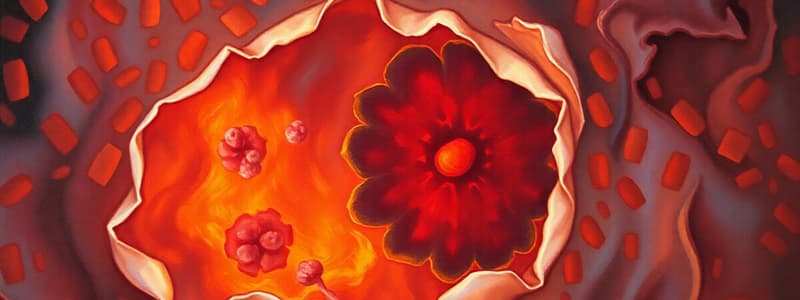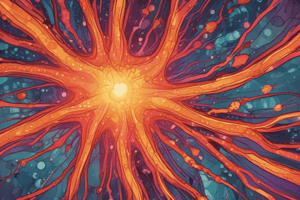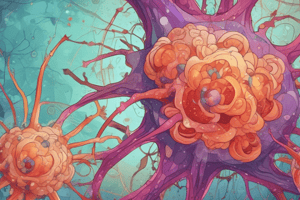Podcast
Questions and Answers
What is one purpose of inflammation?
What is one purpose of inflammation?
- Limit blood flow
- Decrease immune response
- Destroy infectious organisms (correct)
- Reduce tissue healing
Inflammation is a specific response to a particular pathogen.
Inflammation is a specific response to a particular pathogen.
False (B)
What are the cells involved in the inflammatory response?
What are the cells involved in the inflammatory response?
White blood cells (WBCs), endothelial cells, and platelets
Mast cells release __________ during the inflammatory response.
Mast cells release __________ during the inflammatory response.
Which cells arrive during the acute phases of inflammation?
Which cells arrive during the acute phases of inflammation?
Eosinophils play a significant role in the control of inflammation.
Eosinophils play a significant role in the control of inflammation.
What is the function of the clotting system in inflammation?
What is the function of the clotting system in inflammation?
What is one systemic manifestation of acute inflammation?
What is one systemic manifestation of acute inflammation?
Bradykinin is involved in __________ during inflammation.
Bradykinin is involved in __________ during inflammation.
Name the three plasma protein systems involved in inflammation.
Name the three plasma protein systems involved in inflammation.
Which of the following is a role of neutrophils in inflammation?
Which of the following is a role of neutrophils in inflammation?
Flashcards are hidden until you start studying
Study Notes
Purpose of Inflammation
- Destroys infectious and injurious organisms
- Walls off site of infection to limit damage
- Stimulates and enhances immune response
- Stimulates tissue healing and builds a framework for repair
Characteristics of Inflammation
- Occurs in vascular tissues
- Immediate
- Nonspecific
- No memory
- Inflammatory chemicals affect both host and non-host
- Self-limiting
Cells involved in the Inflammatory Response
- White blood cells (WBCs)
- Endothelial cells
- Platelets
Inflammatory Chemicals
- Cytokines
- Vasoactive inflammatory mediators
- Anti-inflammatory mediators
Plasma Protein Systems
- Complement system
- Clotting system
- Kinin system
Activation of the Inflammatory Response
- Trauma to the cell membrane
- Hypoxic injury (examples: myocardial infarction, stroke)
- Chemical injury (examples: aspiration of gastric fluid in lungs, peptic ulcer disease, pancreatitis)
- Immune injury (examples: autoimmune disease, allergic reactions)
- Infection
- Thermal injury (i.e., burns)
- Ionizing radiation
Overview of Inflammatory Response to Cell Injury
- Mast cell degranulation and release of initial vasoactive mediators (e.g., histamine)
- White blood cell margination and migration
- Release of cytokines and inflammatory mediators
- Activation of the plasma protein systems
Mast Cells
- Most important activator of local inflammatory response
- Location: throughout tissues (especially near blood vessels)
- Activators:
- Local cellular injury
- Endotoxin
- Complement proteins
- Immunologic factors: IgE hypersensitivity
- Function:
- Degranulation: release of preformed chemicals
- Histamine: vasodilation, increased capillary permeability, non-vascular smooth muscle contraction
- Histamine Receptors:
- H1 receptors: promote inflammation
- Arterial smooth muscle - vasodilation
- Endothelial cells – endothelial cell retraction/increased capillary permeability
- Bronchial smooth muscle – bronchoconstriction
- WBCs – chemotaxis
- Mast cells – more degranulation
- H2 receptors: inhibit inflammation and have other actions
- Mast cells – inhibits degranulation
- WBCs – inhibits chemotaxis
- Parietal and chief cells lining stomach – HCl and gastric enzyme secretion
- H1 receptors: promote inflammation
- Synthesis of mediators: arachadonic acid (AA) metabolites
- Leukotrienes: actions similar to histamine
- Prostaglandins (PgE 2): actions similar to histamine and induce pain
- Degranulation: release of preformed chemicals
Basophils
- Normal range: 0.4-1.0% of total WBC count
- Function:
- Similar to mast cells - release histamine and leukotrienes in bloodstream
- Also release heparin
Neutrophils (PMNs, segs, polys)
- Normal range: 45-73% of total WBC count
- Immature neutrophils: bands or stabs (normal range: 3-5% of total WBC count)
- Function:
- Arrive during acute phases of inflammation (6-12 hours after degranulation)
- Activated by proinflammatory cytokines (e.g., IL-1 and TNF-alpha)
- Phagocytosis of bacteria and debris – destruction of cells via lysosomal or free radical injury
- Release of inflammatory mediators: more cytokines (interleukins, TNF), platelet activating factor, AA metabolites, etc
Eosinophils
- Normal range: 1-3% of total WBC count
- Function:
- Release chemicals that control inflammation (example: histamine and leukotrienes are inactivated by histaminase and arylsulfatase released by eosinophils)
- Phagocytosis of parasites
- Involved in allergic responses (type I hypersensitivities)
- Phagocytosis of bacteria and yeast (less important role)
Monocytes/Macrophages
- Normal range for monocytes: 4-6% of total WBC count
- Released into the bloodstream by the bone marrow as a monocyte
- Migrate to inflammatory site and transform into a macrophage (triggered by proinflammatory cytokines)
- Many tissues have residential macrophages (liver, spleen, lungs, lymph nodes...)
- Functions:
- Process antigen (activates the immune response)
- Phagocytosis of bacteria and debris
- Release of inflammatory mediators: interleukins, tumor necrosis factor, free radicals, platelet activating factor, proteases, AA metabolites
- Promote wound healing by activating fibroblasts, stimulating angiogenesis, and releasing growth factors
Platelets
- Function in Inflammation:
- Work with coagulation proteins to stop bleeding
- Release approximately 35 other biochemical mediators
- Serotonin: vasoconstriction
- Platelet activating factor (PAF): vasodilation, increased capillary permeability, bronchoconstriction
Endothelial Cells
- Function in inflammation:
- Increased capillary permeability
- Express adhesion molecules for WBC guidance to injury area
- Secretion of vasoactive mediators (nitric oxide, PAF, prostaglandins, etc...)
- Nitric oxide (a.k.a. endothelium-derived relaxation factor (EDRF)): potent vasodilator, also a free radical
Complement System
- 10+ proteins = 10% of plasma proteins; pathways converge at C3
- Classical pathway activation: Presence of antigen-antibody (Ag-Ab) complexes (IgG or IgM complexes only)
- Alternate pathway activation: C3b binds to microbe cell membrane
- Lectin pathway activation: Binding of mannose-binding lectin (MBL) to microbe cell membranes
- Function of activated complement proteins:
- C2a, C3a, C5a: vasodilation, increased capillary permeability, bronchoconstriction
- C2, C3, C3b, C4, C5: opsonization
- C3a and C5a: chemotaxis
- C5 through C9 (membrane attack complex): bacterial (and other) cell lysis
Clotting System
- Sequential activation of a series of clotting factors resulting in the production of fibrin
- Extrinsic and Intrinsic pathways
- Functions of fibrin:
- Forms a meshwork to stop bleeding
- Limits infection
- Forms framework for scar tissue formation
Kinin System
- Functions of Bradykinin:
- Works later and more slowly than histamine
- Vasodilation & increased capillary permeability
- Bronchoconstriction
- Induces pain
Local Manifestations of Inflammation
- Heat & Redness
- Pain
- Edema/Swelling
- Loss of function
Systemic Manifestations of Acute Inflammation
- Fever: caused by endotoxin, interleukin (IL-1), tumor necrosis factor (TNF), prostaglandins
- Leukocytosis: stimulated by granulocyte colony stimulating growth factors (GCSF) from macrophages
- Increased in neutrophils (typically see 70-85% PMNs)
- Increased in bands (typically see 10-20% bands)
- Increased circulating plasma proteins – ‘Acute phase reactants’:
- Released by liver in response to fever, IL-1
- Inflammatory/clotting proteins: Fibrinogen, prothrombin, complement proteins, etc
- Other liver proteins: Ferritin
- C-reactive protein (normal < 1 mg/dL; with bacterial infection see > 10 mg/dL)
- Low albumin/pre-albumin
- Released by liver in response to fever, IL-1
- Increased erythrocyte sedimentation rate (ESR):
- When plasma protein levels in the plasma are elevated (e.g., acute phase reactants released during inflammation), RBCs aggregate and precipitate rapidly
Studying That Suits You
Use AI to generate personalized quizzes and flashcards to suit your learning preferences.




